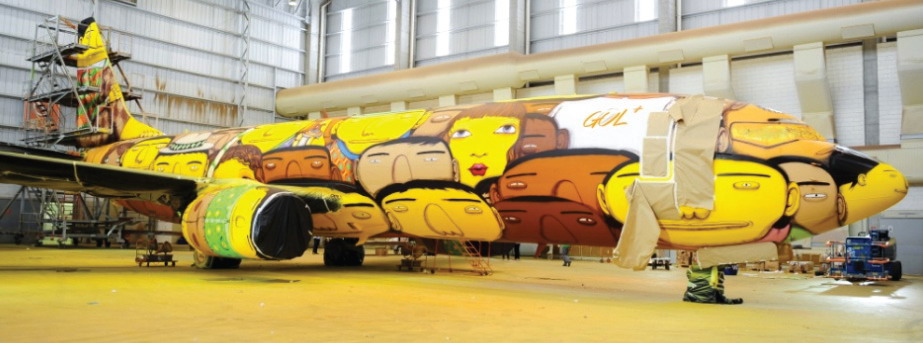Brazil has many famous exports: soccer, samba and supermodels, to name a few. Less recognized, but equally significant, is Brazil’s impact on the global street-art scene. The “Brasil Style” is known for bright colors and whimsical figurative themes. Rio, with its active encouragement of street art, has become world reknown as a hub of this rebellious art form.
As hosts to this year’s World Cup, Brazil will be in the global spotlight. Expectations are high that the National Team will win an unprecedented sixth World Cup trophy.
Hoping to connect these two distinct Brazilian success stories, Sao Paulo natives and internationally recognized street artists Otavio and Gustavo Pandolfo were enlisted to decorate the Brazilian National Soccer Team’s Boeing 737. Known as “Os Gemeos”, or “The Twins”, the brothers have been painting colorful and ambitious murals worldwide since 1987.
After conceptualizing and planning, they taped off the plane, and the free-form spraying began. Some 1,200 spray cans later, the transformation was complete. The brothers want the plane to be noticed wherever it goes, and their whimsical graphics have absolutely achieved that goal.
Noticeable? Yes. Successful? I’m not so sure. Let me explain why.
The Brazilian National Team is a multi-billion-dollar global brand. It carries certain expectations and responsibilities. Fans think of Pelé, pinpoint passing and a joyful style of play. That joy often includes a cheeky exuberence, but not cartoonish whimsy. The bold airplane design certainly reflects the style of its creators, but does it reflect the style of the soccer team? I don’t think so.
Advertisement
One could argue that the “Samba Circus” atmosphere that follows the team’s global superstars, and the frenzied legion of fans that accumulates wherever the team plays, proves the appropriate nature of the design.
However, I find the design to be confusing: Who are these yellow cartoon characters, and why are they on this plane? The only tenuous tether to the proud nation of Brazil is the color scheme, which generally aligns with the nation’s iconic flag and team jersey colors.
ST has published its Vehicle Graphics contest for eight years, and the staff often discusses the winning entries and whether we consider them “successful”.
Two schools of thought pervade. One faction values crazy, chaotic graphics and bright, saturated colors. Attracting attention and standing out in the crowd is the main goal. This can come in handy if the intent is only to stand out. The “wow” factor often comes at the expense of legibility. In the hands of a lesser artist, this type of design can quickly become a hot mess.
The other school prefers to let the brand speak for itself and stresses a message, not unlike a billboard. Website URLs, phone numbers and catchphrases are legibly presented. Be careful, though: do this type of design the wrong way, and it looks boring and can go unnoticed.
Getting back to the Brazil team plane, I think the plane’s design should have taken a more understated approach. A little elegance and confidence go a long way.
Advertisement
On the other hand, Brazil is known for samba, supermodels and soccer, so maybe wild and crazy hits the right note. The team is less flashy on-field this year, and the team plane could help bring some swagger.
Let me know which direction you advise when creating vehicle decorations for your clients. I’ll tabulate the responses and post results in my next column.



 Tip Sheet2 weeks ago
Tip Sheet2 weeks ago
 Photo Gallery4 days ago
Photo Gallery4 days ago
 Ask Signs of the Times6 days ago
Ask Signs of the Times6 days ago
 Paula Fargo1 day ago
Paula Fargo1 day ago
 Real Deal2 weeks ago
Real Deal2 weeks ago
 Benchmarks1 week ago
Benchmarks1 week ago
 Photo Gallery1 day ago
Photo Gallery1 day ago
 Women in Signs2 weeks ago
Women in Signs2 weeks ago







